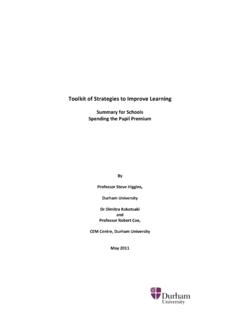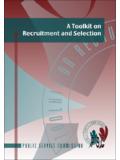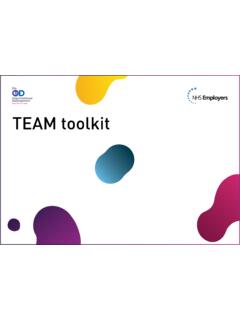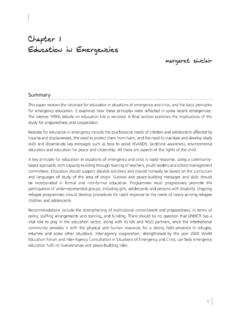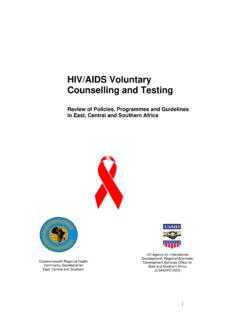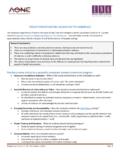Transcription of Guidance on Testing Data Reliability - Auditor Roles
1 Guidance on Testing data Reliability January 2004. Office of the City Auditor Austin, Texas City Auditor Stephen L. Morgan, CIA, CFE, CGAP, CGFM. Deputy City Auditor Colleen G. Waring, CIA, CGAP, CGFM. Please send any questions or comments to: data Reliability Testing . What is data Reliability ? data Reliability is a state that exists when data is sufficiently complete and error free to be convincing for its purpose and context. In addition to being reliable, data must also meet other tests for evidence. Computer-processed data must meet evidence standards before it can support a finding. For all types of evidence, various tests are used sufficiency, competence, and relevance to assess whether the GAGAS standard for evidence is met. Per GAGAS, evidence is: relevant if it has a logical, sensible relationship to the finding it supports. What data is relevant to answering an audit objective is usually self-evident, presuming a precise objective written as a question. Timeliness (the age of the evidence) must be considered, as outdated data is considered irrelevant.
2 As a result, relevance is closely tied to the scope of the audit work, which establishes what time period will be covered. data is relevant if they have a logical, sensible relationship to the overall audit objective in terms of: the audit subject the aspect of performance being examined the finding element to which the evidence pertains, and the time period of the issue being audited sufficient if there is enough of it to support the finding. Sufficiency establishes that evidence or data provided has not been overstated or inappropriately generalized. Like relevance, sufficiency must be judged in relationship to the finding element to which the data pertains, and is closely tied to the audit scope. The audit scope establishes what portion of the universe is covered (important for sufficiency) through 3 choices: 1. obtain data on (mine) the entire universe 2. sample the universe 3. limit findings to that portion or segment of the universe they examine competent if it both valid and reliable.
3 In assessing computer-processed data , the focus is usually on one test in the evidence standard competence which includes both validity and Reliability . Per GAGAS, "Auditors should determine if other auditors have worked to establish the validity and Reliability of the data or the effectiveness of the controls over the system that produced it. If they have, auditors may be able to use that work. If not, auditors can obtain evidence about the competence of computer-processed data by direct tests of the data (through or around the computer, or a combination of both.) Auditors can reduce the direct tests of the data if they test the effectiveness of general and application controls over computer-processed data , and these tests support the conclusion that controls are effective.". The fundamental criterion for judging data competence is: "Are we reasonably confident that the data presents a picture that is not significantly different from reality?" The criterion is NOT simply "Are we sure the data is accurate?
4 " In order to address competence, the data must be more than accurate, it must also be valid, complete, and unaltered. Validity refers to whether the data actually represent what you think is being measured. For example, is the data field "annual evaluation score" an appropriate measure of a person's job performance? Does a field named "turnaround time" appropriately measure the cycle that it purports to represent? While validity must be considered, this discussion focuses on Reliability . 1 of 8. data Reliability Testing . data Reliability refers to the accuracy and completeness of computer-processed data , given the intended purposes for use. Reliability does not mean that computer-processed data is error- free. It means that any errors found were within a tolerable range - that you have assessed the associated risk and found the errors are not significant enough to cause a reasonable person, aware of the errors, to doubt a finding, conclusion, or recommendation based on the data .
5 data can refer to either information that is entered into a system or information generated as a result of computer processing. data is considered reliable when it is: COMPLETE - includes all of the data elements and records needed for the engagement. A data element is a unit of information with definable parameters ( a Social Security #) and is also called a data variable or data field ACCURATE: CONSISTENT - data was obtained and used in a manner that is clear and well- defined enough to yield similar results in similar analyses. CORRECT - the data set reflects the data entered at the source (or if available source documents) and/or properly represents the intended ( calculated) results. UNALTERED data reflects source and has not been tampered with. Making a preliminary assessment of data Reliability Simple steps that provide the basis for making a preliminary assessment of data Reliability include collecting known information about the data , performing initial Testing of the data , and assessing risk related to the intended use of the data .
6 REVIEW EXISTING INFORMATION. Determine what is already known about the accuracy and the completeness of the entry and processing of the data , as well as how data integrity is maintained. Sources for related information can be found within the agency under review and externally among the customers and data users. This may be in the form of reports, studies, or interviews with knowledgeable users of the data and the system. Computers are almost always programmed to edit data that is entered for processing. These edits help determine whether the data is acceptable. If a transaction contains errors or fails to meet established edit criteria, it is rejected. A computer record of rejected transactions should be available from the control group responsible for reviewing output. Exercise care in reaching conclusions about these edit tests because a system with insufficient computer edits may routinely accept bad data and reject few transactions, while a system with extensive edits may reject many transactions but actually produce a far more accurate final product.
7 Auditors should ask how management monitors for problems with the computer system while discussing and obtaining standing reports ( for security violations, exceptions, bypasses, overrides, etc.). These discussions and documents are also useful to help review the extent of any known problems with the system. PERFORM INITIAL Testing . Apply logical tests to electronic data files or hard copy reports. For electronic data , use computer programs to test all entries of key data elements you plan to use for the engagement. Testing with computer programs ( Excel, Access, ACL, SPSS, etc.) often takes less than a day, depending on the complexity of the file. 2 of 8. data Reliability Testing . For hard copy or summarized data (whether provided by the audited entity or retrieved from the internet) you can ask for the electronic data file used to create it. If you are unable to obtain electronic data , use the hard copy or summarized data and, to the extent possible, manually apply the tests to all key data elements or (if the report or summary is too voluminous) to a sample of them.
8 Be sure to keep a record or log of your Testing for your workpapers! Whether you have an electronic file or a hard copy report or summary, you apply the same tests to the data , which can include Testing for things like: missing data (either entire records or values of key data elements). the relationship of one data element to another ( male patients with prenatal care). values outside of a designated range ( driver's license age under 14). dates outside valid time frames or in an illogical progression ( died before born!). ASSESS RISK RELATED TO data Reliability . In making the preliminary assessment, consider the data in the context of the final report and how big a role the data will play: Will the audit depend on the data alone to answer a research question (objective)? Will the data be summarized or will detailed information be required? Is it important to have precise data , making the magnitude of errors an issue? You should consider the extent to which corroborating evidence is likely to exist and will independently support your findings/recommendations.
9 Corroborating evidence is independent evidence that supports information found in the database. Such evidence, if available, can be found in the form of alternative databases or expert views. Corroborating evidence is unique to each engagement, and its strength (or persuasiveness) varies - for help in judging the strength or weakness of corroborating evidence, consider the extent to which it: 1. meets Yellow Book standards of evidence (sufficient, competent, and relevant), 2. provides crucial support, 3. is drawn from different types of sources (testimonial, documentary, physical, or analytical), 4. is independent of other sources. Risk is the likelihood that using data of questionable Reliability could have significant negative consequences to the decisions of policymakers and others. A risk assessment should consider the following risk conditions: The data could be used to influence legislation or policy with significant impact. The data could be used for significant decisions by individuals or organizations.
10 The data will be the basis for numbers that are likely to be widely quoted. The engagement is concerned with a sensitive or controversial subject. The engagement has external stakeholders who have taken positions on the subject. The overall engagement risk is medium or high. The engagement has unique factors that strongly increase risk. Bear in mind that any one of the above conditions may have more importance than another, depending upon the engagement. Be sure to document in the workpapers your analysis of risk in terms of the role the data is to play in your audit and the use of it by other people versus the strength of corroborating evidence. SUMMARIZE PRELIMINARY RESULTS. The overall assessment of Reliability is a judgment call. The outcome of the assessment is going to vary based upon your combined judgments of the strength of the corroborating evidence and the degree of risk involved. If the corroborating 3 of 8. data Reliability Testing . evidence is strong and the risk is low, the data is more likely to be considered sufficiently reliable for your purposes.

